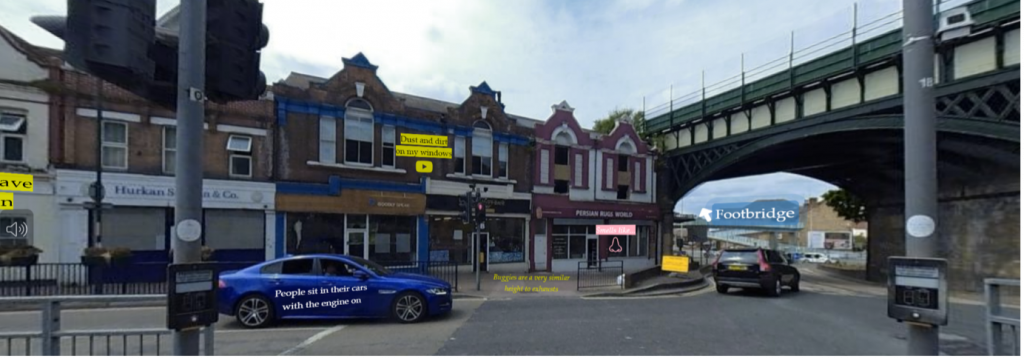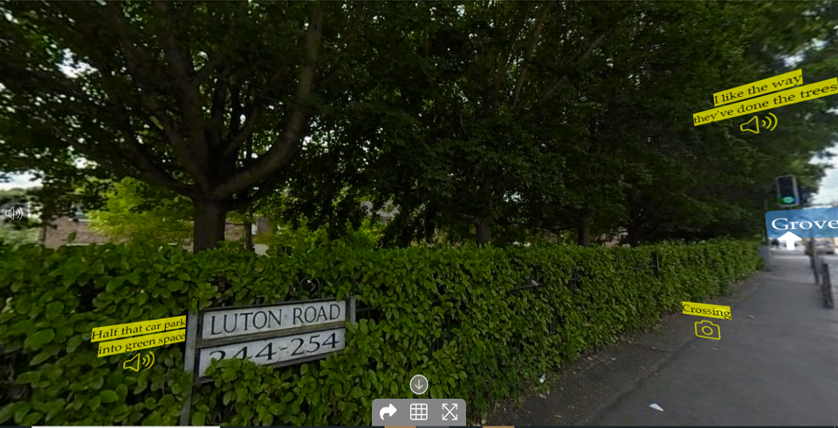In this contribution to Bulletin 29, Eleanor Jupp reflects her findings during a period of fieldwork in a neglected and often stigmatised neighbourhood in Chatham, Kent.
Eleanor Jupp
University of Kent
Image by Alexander Andrews (via Unsplash).
How might university researchers contribute to climate justice in our localities? Last year I collaborated with academics, residents and artists undertaking research on health and environmental issues in an area of Chatham, Kent, near to where my university has a campus. Here I offer an overview and reflections on this project.
Background
I came to the project with an interest in the forms of activism that emerge in the contexts of contemporary crises—environmental, economic and political. In particular, I am interested in how ‘care’, broadly understood, can be a mobilising force for activism, especially in marginalised communities and places.[1] Recently I have been researching initiatives such as community fridges and pantries to address food waste and food insecurity, and other forms of mutual aid, as ‘hyperlocal’ responses to overlapping crises. Foregrounding care in relation to environmental initiatives underlines the need to challenge purely ‘technoscientific’ solutions[2]—and pay attention to the affective, ethical and political affordances of tools for transition, if we are to have a critical approach to environmental justice.
Indeed, in my thinking on care and climate justice I am particularly influenced by the work of María Puig de la Bellacasa—and her engagement with a wider range of science and technology studies.[3] This involves thinking through care in ‘more-than-human’ worlds or ‘natureculture’.[4] Care, in Puig de la Bellacasa’s work, drawing on Tronto’s theorisation,[5]always involves practices, affects and ethics or ‘hand, brain and heart’,[6] offering a feminist approach to engagement with the terrains seen as dominated by natural sciences.
For this project, rather than a critical account of existing interventions, our engagement on Luton Road in Chatham, Kent, approached technology differently—to consider how digital technology (and its affective qualities) can be used to give voice to residents of a neglected and stigmatised neighbourhood. Overall, it considers how a care-full approach to technology can actively contribute to a critical climate justice.[7]
Stories of Luton Road
For the project I collaborated with other researchers at the University of Kent—Kate McLean, Becky Alexis-Martin, and Elise Wynkoop. The digital visualisations produced were created by artist Kevin Grist and colleagues at Electric Medway, working within community arts organisation Ideas Test. We also worked with community organisation Arches Local—as well as local residents themselves.
The Luton Road area in Kent is a stigmatised road in a wider post-industrial urban area, Chatham, which is in itself also stigmatised.[8] It is a mile-long road in an area of high crime, deprivation, and poor health—not an area necessarily thought about in terms of climate justice. The initial framing of the project was to be about addressing health inequalities. It became clear when talking to local government officials that health concerns for the area could actually contribute to senses of stigma, within discourses of individual ‘behaviour change’—for example, how to tackle obesity, smoking, and ‘unhealthy choices’.[9] I would argue that this discourse is itself a symptom of austerity, whereby tackling poverty and inequality as wider determinants of health are out of reach in a context of reduced budgets.
However, when we began talking to residents, they engaged us in discussions about air pollution, poor lung health, and asthma due to a car dominated environment, in the context of a wider neglect and lack of care for the area among decision makers, and feelings of fear and risk in public spaces. There is very poor air quality in particular.[10] The neighbourhood is subject to statutory air quality monitoring, but there were feelings of despair among the residents about this improving. Luton Road is a very busy road that leads to other more affluent areas and the sense of the road as somewhere to pass through is the dominant way it is discussed among local decision makers. ‘Levelling up’ money is being spent on improving the nearby town centre shopping environment but not on Luton Road.[11] Indeed, in thinking about the role of universities in tackling climate crisis, there is a need to be aware of the potential for researchers to be drawn into a largely neoliberal politics of dominant local political discourses and decision-making.
Spending time on the Road as researchers, we became aware that it is a multicultural area, with many fairly recent migrants as well as a longer established working-class white population connected to work at the nearby Dockyard. Along the road are large Victorian houses which have mainly been divided up into flats and are neglected. Much housing was owned by private landlords operating at the ‘edges’ of the welfare state providing temporary and supported housing.[12] Overall it feels like an unregulated environment where the state and wider forms of care are largely absent. Residents spoke to us about tensions and pressures experienced including racism, violent crime, a lack of meeting places, and a lack of wider infrastructures of care. One of the most visible symptoms of neglect is the presence of rubbish and fly-tipping, indicating a lack of basic infrastructure around rubbish collection. Such neglect clearly links to austerity.
However, residents do care about and care for their road within this wider context of neglect. We therefore wanted to use the research to challenge dominant understandings of the Road—and to bring centre stage what it is like to live there, to walk along it, and the hopes and fears of residents. We walked along the Road with fifteen diverse residents undertaking in-depth ‘go-along’ multi-sensory interviews, as well as attending local events. This process involved collecting audio stories, sounds, images as well monitoring air quality. My colleague Kate McLean made collaborative ‘smell maps’ through walks to collect smells on the road.[13]
In spending this time and attention on the Road, we were seeking to enact caring for ‘neglected things’.[14] We wanted to collectively attune ourselves to the environment of the Road in new ways, and then use the affective affordances of a digital environment to communicate this attention and care for others. Artist Kevin Grist enabled us to present our research data in this multi-sensory way, using a digital environment in which viewers can listen to voices of residents mapped onto images and words, and can ‘explore’ in the way viewers might explore platforms such as Google Streetview. This technology allowed us to animate interview data alongside the sounds and sights around which it was generated. The visualisation therefore seeks to provide a platform and intervention into local decision making about the road.
Below is one image from this visualisation, highlighting themes of air pollution and risks to health.

Discussion of air pollution was tied up with wider feelings about an unsafe and unhealthy environment and of fear and risk, especially for children. These feelings in themselves contribute to car use among local residents—although many people driving along the road are not residents. Nonetheless, it is important to note that aspirations, hopes, and positive experiences of community and friendship were discussed during interviews too. These included positive feelings about planting trees and flowers and creating more green spaces—both in the present and aspired for in the future.
Conclusions
In researching on Luton Road it became clear that environmental justice needed to be placed within a wider context of austerity and failures of care—involving housing, planning, and welfare. Within a neglected, stigmatised, and fearful public sphere it becomes harder to move away from car dominance in particular. This prompts us to consider who is seen to deserve having their environment and health protected? When we talk about environmental justice, who is included?
A project such as this experiments with a phenomenological politics of attention to engage with climate justice,[15] in which digital technology can play an important role. More broadly, issues such as air quality, carbon emissions, and rising temperatures can be largely invisible. In certain times and places they may become highly visible—but then dominant attentions can be quickly pulled elsewhere. Our methods involved slowing down residents’ attention as well as our own as researchers, and as viewers of the digital environment. Going into digital environments can enable an experiential immersive involvement in place, and there is more to consider around how such environments can draw attention within a critical climate justice framework more widely.
As already noted, hopeful feelings on the road centred around a scheme to plant trees a few months earlier. We were told that the project had been resisted as officials thought they would be vandalised, within a wider set of feelings that environmental improvements were not ‘deserved’ on the Road. However, this had not happened, and as well as contributing to improving air quality, the trees provided a connection to nature that residents often craved. Even more powerfully, they provided an example of something changing and an antidote to despair.

Footnotes
[1] E. Jupp, Care, Crisis and Activism: The Politics of Everyday Life (Bristol, 2022: Policy Press).
[2] A. Martin, N. Myers & A. Viseu, ‘The Politics of Care in Technoscience’, Social Studies of Science 45, no. 5 (2015): 625-641.
[3] M. Puig de La Bellacasa, Matters of Care: Speculative Ethics in More Than Human Worlds (Minneapolis, MN 2017: University of Minnesota Press).
[4] D. Haraway, Simians, Cyborgs, and Women: The Reinvention of Nature (London 2013: Routledge).
[5] J.C. Tronto, ‘An Ethic of Care’, Generations: Journal of the American society on Aging, 22, no. 3 (1998): 15–20.
[6] H. Rose, ‘Hand, Brain, and Heart: A Feminist Epistemology for the Natural Sciences’, Signs: journal of Women in Culture and Society 9, no. 1 (1983): 73-90.
[7] M.J. Williams, ‘Care‐full Justice in the City’, Antipode 49, no. 3 (2017): 821-839; F. Sultana, ‘Resplendent Care-full Climate Revolutions’, Political Geography 99, no. 1 (2022): 102638.
[8] Keely Greenwood, ‘Our reporter visits Luton, Chatham, after area is slammed in survey’, Kent Online 22 February 2023, https://www.kentonline.co.uk/medway/news/despite-what-people-say-its-just-not-that-bad-282555/.
[9] R. Jones, J. Pykett, & M. Whitehead, ‘Behaviour Change Policies in the UK: An Anthropological Perspective’, Geoforum 48 (2013): 33-41.
[10] Medway Labour, ‘Medway Labour motion to declare Climate Emergency’, 12 April 2019, https://www.medwaylabour.org.uk/medway-labour-motion-climate-emergency/.
[11] Medway Council, ‘Medway to receive nearly £14.5million government funding’, 28 October 2021, https://www.medway.gov.uk/news/article/1037/medway_to_receive_nearly_145million_government_funding.
[12] E. Jupp, ‘Affective Geographies of Governance and Care in the Fraying Welfare State’, unpublished working paper.
[13] C. Perkins & K. McLean, ‘Smell Walking and Mapping’ in: H. Holmes & S.M. Hall (eds.), Mundane Methods (Manchester 2020: Manchester University Press): 156–173.
[14] Puig de La Bellacasa, Matters of Care.
[15] D. Seamon, ‘Lived Bodies, Place, and Phenomenology: Implications for Human Rights and Environmental Justice’, Journal of Human Rights and the Environment 4, no. 2 (2013): 143-166.
Biography
Dr Eleanor Jupp in Reader in Social Policy at the University of Kent. Her most recent book, Care, Crisis and Activism: The Politics of Everyday Life, was published by Policy Press in 2022. She was an ISRF Political Economy Fellow between 2021 and 2022.





